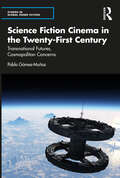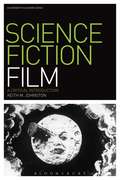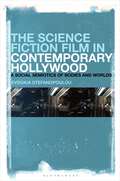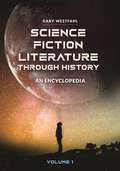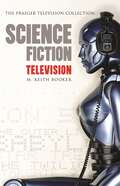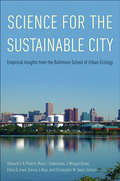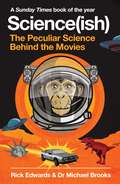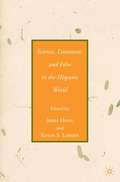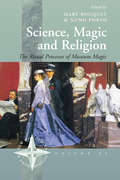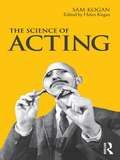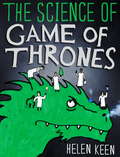- Table View
- List View
Science Fiction Cinema in the Twenty-First Century: Transnational Futures, Cosmopolitan Concerns (Studies in Global Genre Fiction)
by Pablo Gómez-MuñozRecent films are increasingly using themes and conventions of science fiction such as dystopian societies, catastrophic environmental disasters, apocalyptic scenarios, aliens, monsters, time travel, teleportation, and supernatural abilities to address cosmopolitan concerns such as human rights, climate change, economic precarity, and mobility. This book identifies and analyses the new transnational turn towards cosmopolitanism in science fiction cinema since the beginning of the twenty-first century. The book considers a wide selection of examples, including case studies of films such as Elysium, In Time, 2012, Andrew Niccol’s The Host, Codependent Lesbian Space Alien Seeks Same, and Cloud Atlas. It also questions the seeming cosmopolitanism of these narratives and exposes how they sometimes reproduce social hierarchies and exploitative practices. Dealing with diverse, interdisciplinary concerns represented in cinema, this book in the Studies in Global Genre Fiction series will be of interest to readers and scholars working in the fields of science fiction, film and media studies, cosmopolitanism, border theory, popular culture, and cultural studies. It will also appeal to fans of science fiction cinema and literature.
Science Fiction Cinema in the Twenty-First Century: Transnational Futures, Cosmopolitan Concerns (Studies in Global Genre Fiction)
by Pablo Gómez-MuñozRecent films are increasingly using themes and conventions of science fiction such as dystopian societies, catastrophic environmental disasters, apocalyptic scenarios, aliens, monsters, time travel, teleportation, and supernatural abilities to address cosmopolitan concerns such as human rights, climate change, economic precarity, and mobility. This book identifies and analyses the new transnational turn towards cosmopolitanism in science fiction cinema since the beginning of the twenty-first century. The book considers a wide selection of examples, including case studies of films such as Elysium, In Time, 2012, Andrew Niccol’s The Host, Codependent Lesbian Space Alien Seeks Same, and Cloud Atlas. It also questions the seeming cosmopolitanism of these narratives and exposes how they sometimes reproduce social hierarchies and exploitative practices. Dealing with diverse, interdisciplinary concerns represented in cinema, this book in the Studies in Global Genre Fiction series will be of interest to readers and scholars working in the fields of science fiction, film and media studies, cosmopolitanism, border theory, popular culture, and cultural studies. It will also appeal to fans of science fiction cinema and literature.
Science Fiction Film: A Critical Introduction (Film Genres)
by Keith M. JohnstonScience Fiction Film develops a historical and cultural approach to the genre that moves beyond close readings of iconography and formal conventions. It explores how this increasingly influential genre has been constructed from disparate elements into a hybrid genre.Science Fiction Film goes beyond a textual exploration of these films to place them within a larger network of influences that includes studio politics and promotional discourses. The book also challenges the perceived limits of the genre - it includes a wide range of films, from canonical SF, such as Le voyage dans la lune, Star Wars and Blade Runner, to films that stretch and reshape the definition of the genre. This expansion of generic focus offers an innovative approach for students and fans of science fiction alike.
Science Fiction Film: A Critical Introduction (Film Genres)
by Keith M. JohnstonScience Fiction Film develops a historical and cultural approach to the genre that moves beyond close readings of iconography and formal conventions. It explores how this increasingly influential genre has been constructed from disparate elements into a hybrid genre.Science Fiction Film goes beyond a textual exploration of these films to place them within a larger network of influences that includes studio politics and promotional discourses. The book also challenges the perceived limits of the genre - it includes a wide range of films, from canonical SF, such as Le voyage dans la lune, Star Wars and Blade Runner, to films that stretch and reshape the definition of the genre. This expansion of generic focus offers an innovative approach for students and fans of science fiction alike.
The Science Fiction Film in Contemporary Hollywood: A Social Semiotics of Bodies and Worlds
by Evdokia StefanopoulouThe Science Fiction Film in Contemporary Hollywood focuses on the American science fiction (SF) film during the period 2001-2020, in order to provide a theoretical mapping of the genre in the context of Conglomerate Hollywood. Using a social semiotics approach in a systematic corpus of films, the book argues that the SF film can be delineated by two semiotic squares -the first one centering on the genre's more-than-human ontologies (SF bodies), and the second one focusing on its imaginative worlds (SF worlds). Based on this theoretical framework, the book examines the genre in six cycles, which are placed in their historical context, and are analyzed in relation to cultural discourses, such as technological embodiment, race, animal-human relations, environmentalism, global capitalism, and the techno-scientific Empire. By considering these cycles -which include superhero films, creature films, space operas, among others-as expressions of the genre's basic oppositions, the book facilitates the comparison and juxtaposition of films that have rarely been discussed in tandem, offering a new perspective on the multiple articulations of the SF film in the new millennium.
The Science Fiction Film in Contemporary Hollywood: A Social Semiotics of Bodies and Worlds
by Evdokia StefanopoulouThe Science Fiction Film in Contemporary Hollywood focuses on the American science fiction (SF) film during the period 2001-2020, in order to provide a theoretical mapping of the genre in the context of Conglomerate Hollywood. Using a social semiotics approach in a systematic corpus of films, the book argues that the SF film can be delineated by two semiotic squares -the first one centering on the genre's more-than-human ontologies (SF bodies), and the second one focusing on its imaginative worlds (SF worlds). Based on this theoretical framework, the book examines the genre in six cycles, which are placed in their historical context, and are analyzed in relation to cultural discourses, such as technological embodiment, race, animal-human relations, environmentalism, global capitalism, and the techno-scientific Empire. By considering these cycles -which include superhero films, creature films, space operas, among others-as expressions of the genre's basic oppositions, the book facilitates the comparison and juxtaposition of films that have rarely been discussed in tandem, offering a new perspective on the multiple articulations of the SF film in the new millennium.
Science Fiction Literature through History [2 volumes]: An Encyclopedia [2 volumes]
by Gary WestfahlThis book provides students and other interested readers with a comprehensive survey of science fiction history and numerous essays addressing major science fiction topics, authors, works, and subgenres written by a distinguished scholar.This encyclopedia deals with written science fiction in all of its forms, not only novels and short stories but also mediums often ignored in other reference books, such as plays, poems, comic books, and graphic novels. Some science fiction films, television programs, and video games are also mentioned, particularly when they are relevant to written texts. Its focus is on science fiction in the English language, though due attention is given to international authors whose works have been frequently translated into English.Since science fiction became a recognized genre and greatly expanded in the 20th century, works published in the 20th and 21st centuries are most frequently discussed, though important earlier works are not neglected. The texts are designed to be helpful to numerous readers, ranging from students first encountering science fiction to experienced scholars in the field.
Science Fiction Literature through History [2 volumes]: An Encyclopedia [2 volumes]
by Gary WestfahlThis book provides students and other interested readers with a comprehensive survey of science fiction history and numerous essays addressing major science fiction topics, authors, works, and subgenres written by a distinguished scholar.This encyclopedia deals with written science fiction in all of its forms, not only novels and short stories but also mediums often ignored in other reference books, such as plays, poems, comic books, and graphic novels. Some science fiction films, television programs, and video games are also mentioned, particularly when they are relevant to written texts. Its focus is on science fiction in the English language, though due attention is given to international authors whose works have been frequently translated into English.Since science fiction became a recognized genre and greatly expanded in the 20th century, works published in the 20th and 21st centuries are most frequently discussed, though important earlier works are not neglected. The texts are designed to be helpful to numerous readers, ranging from students first encountering science fiction to experienced scholars in the field.
Science Fiction Television (The Praeger Television Collection)
by M. Keith BookerScience fiction series have remained a staple of American television from its inception: classic programs such as The Twilight Zone, The Outer Limits, and Star Trek, along with recent and current series including Babylon 5 and Stargate SG-1, have been some of the most enduring and influential of all television shows. In this chronological survey, author M. Keith Booker examines this phenomenon and provides in-depth studies of the most important of these series. Science Fiction Television traces the development of the genre as a distinct cultural phenomenon within the context of broader developments in American culture as a whole.In the process, it offers a unique and informative guide for television fans and science fiction fans alike, one whose coverage is unprecedented in its scope and breadth. A must-read for anyone interested in its subject or in American popular culture, Science Fiction Television is a perceptive and entertaining history of one of television's most lasting forms of entertainment.
Science Fiction TV (Routledge Television Guidebooks)
by J. P. TelotteThe first in the Routledge Television Guidebooks series, Science Fiction TV offers an introduction to the versatile and evolving genre of science fiction television, combining historical overview with textual readings to analyze its development and ever-increasing popularity. J. P. Telotte discusses science fiction’s cultural progressiveness and the breadth of its technological and narrative possibilities, exploring SFTV from its roots in the pulp magazines and radio serials of the 1930s all the way up to the present. From formative series like Captain Video to contemporary, cutting-edge shows like Firefly and long-lived popular revivals such as Doctor Who and Star Trek, Telotte insightfully tracks the history and growth of this crucial genre, along with its dedicated fandom and special venues, such as the Syfy Channel. In addition, each chapter features an in-depth exploration of a range of key historical and contemporary series, including: -Captain Video and His Video Rangers -The Twilight Zone -Battlestar Galactica -Farscape -Fringe Incorporating a comprehensive videography, discussion questions, and a detailed bibliography for additional reading, J. P. Telotte has created a concise yet thought-provoking guide to SFTV, a book that will appeal not only to dedicated science fiction fans but to students of popular culture and media as well.
Science Fiction TV (Routledge Television Guidebooks)
by J. P. TelotteThe first in the Routledge Television Guidebooks series, Science Fiction TV offers an introduction to the versatile and evolving genre of science fiction television, combining historical overview with textual readings to analyze its development and ever-increasing popularity. J. P. Telotte discusses science fiction’s cultural progressiveness and the breadth of its technological and narrative possibilities, exploring SFTV from its roots in the pulp magazines and radio serials of the 1930s all the way up to the present. From formative series like Captain Video to contemporary, cutting-edge shows like Firefly and long-lived popular revivals such as Doctor Who and Star Trek, Telotte insightfully tracks the history and growth of this crucial genre, along with its dedicated fandom and special venues, such as the Syfy Channel. In addition, each chapter features an in-depth exploration of a range of key historical and contemporary series, including: -Captain Video and His Video Rangers -The Twilight Zone -Battlestar Galactica -Farscape -Fringe Incorporating a comprehensive videography, discussion questions, and a detailed bibliography for additional reading, J. P. Telotte has created a concise yet thought-provoking guide to SFTV, a book that will appeal not only to dedicated science fiction fans but to students of popular culture and media as well.
Science for the Curious Photographer: An Introduction to the Science of Photography
by Charles S. Johnson Jr.While there are many books that teach the "how-to" of photography, Science for the Curious Photographer is a book for those who also want to understand how photography works. Beginning with an introduction to the history and science of photography, Charles S. Johnson, Jr. addresses questions about the principles of photography, such as why a camera needs a lens, how lenses work, and why modern lenses are so complicated. Addressing the complex aspects of digital photography, the book discusses color management, resolution, "noise" in images, and the limits of human perception. The creation and appreciation of art in photography is discussed from the standpoint of modern cognitive science. A crucial read for those seeking the scientific context to photographic practice, this second edition has been comprehensively updated, including discussion of DSLRs, mirror-less cameras, and a new chapter on the limits of human vision and perception.
Science for the Curious Photographer: An Introduction to the Science of Photography
by Charles S. Johnson, Jr.While there are many books that teach the "how-to" of photography, Science for the Curious Photographer is a book for those who also want to understand how photography works. Beginning with an introduction to the history and science of photography, Charles S. Johnson, Jr. addresses questions about the principles of photography, such as why a camera needs a lens, how lenses work, and why modern lenses are so complicated. Addressing the complex aspects of digital photography, the book discusses color management, resolution, "noise" in images, and the limits of human perception. The creation and appreciation of art in photography is discussed from the standpoint of modern cognitive science. A crucial read for those seeking the scientific context to photographic practice, this second edition has been comprehensively updated, including discussion of DSLRs, mirror-less cameras, and a new chapter on the limits of human vision and perception.
Science for the Sustainable City: Empirical Insights from the Baltimore School of Urban Ecology
by Steward T. A. Pickett Mary L. Cadenasso J. Morgan Grove Elena G. Irwin Emma J. Rosi Christopher M. SwanA presentation of key findings and insights from over two decades of research, education, and community engagement in the acclaimed Baltimore Ecosystem Study In a world of more than seven billion people—who mostly reside in cities and towns—the Baltimore Ecosystem Study is recognized as a pioneer in modern urban social-ecological science. After two decades of research, education, and community engagement, there are insights to share, generalizations to examine, and research needs to highlight. This timely volume synthesizes the key findings, melds the perspectives of different disciplines, and celebrates the benefits of interacting with diverse communities and institutions in improving Baltimore’s ecology. These widely applicable insights from Baltimore contribute to our understanding the ecology of other cities, provide a comparison for the global process of urbanization, and inform establishment of urban ecological research elsewhere. Comprehensive, interdisciplinary, and highly original, it gives voice to the wide array of specialists who have contributed to this living urban laboratory.
Science(ish): The Peculiar Science Behind the Movies
by Rick Edwards Michael BrooksA Sunday Times Book of the Year A New Scientist Gift Pick "Bright, nerdy and funny! Of course I loved it." Dara O BriainCan we resurrect dinosaurs, Jurassic Park-style? Are we living in The Matrix's digital simulation? Do aliens with acid blood exist somewhere in the universe? Will we ever go back and visit 1955? And just why were the original Planet of the Ape movies so terrible?In Science(ish), Rick Edwards and Dr Michael Brooks confront all the questions that your favourite movies provoke. Inspired by their award-winning podcast, this popular (hopefully) science (definitely) book dedicates each chapter to a different sci-fi classic, and wittily explores the fascinating issues that arise. Covering movies from 28 Days Later to Ex Machina, this is a joyous ride through astrophysics, neuroscience, psychology, botany, artificial intelligence, evolution, and plenty more subjects you've always wanted to grasp. Now's your chance: stylishly designed and illustrated throughout, Science(ish) is the perfect gift for every curious mind.
Science, Literature, and Film in the Hispanic World
by J. Hoeg K. LarsenDriven by such diverse advances as the Human Genome Project and the explosion of the World Wide Web, and also by the threat of human-inspired disasters such as global warming, the field of science and literature studies is currently undergoing an unprecedented expansion. The relations between science and literature have been and continue to be central to understanding Hispanic civilization and culture. In spite of this, Science, Literature, and Film in the Spanish-Speaking World is the first and only book to treat this new and dynamic field from an Hispanic perspective. This unique volume opens the door to an entirely new focus in the study of Hispanic literature and culture.
Science, Magic and Religion: The Ritual Processes of Museum Magic (New Directions in Anthropology #23)
by Mary Bouquet Nuno PortoFor some time now, museums have been recognized as important institutions of western cultural and social life. The idea of the museum as a ritual site is fairly new and has been applied to the art museums in Europe and the United States so far. This volume expands it by exploring a range of contemporary museums in Europe and Africa. The case studies examine the different ways in which various actors involved in cultural production dramatize and ritualize such sites. It turns out that not only museum specialists, but visitors themselves are engaged in complex performances and experiences that make use of museums in often unexpected ways.
Science Meets Art
by John Potts Nigel HelyerThis book explores collaboration between artists and scientists and examines the ways in which scientific data and research findings can be communicated, translated and transformed using the techniques of contemporary art and information technology. Contemporary art forms—including installation, sculpture, painting, computer-based art, Internet art and interactive electronic artworks—are able to provide new and creative outlets, with expanded audiences, for scientific research. The book, which features 75 illustrations of works created as a result of art–science collaboration between scientists and artists, is important in the field because it presents a thorough account of the collaboration through the eyes of a leading creative practitioner and a leading cultural theorist. It contains a wide range of in-detail examples of successful collaborative works that illustrate the breadth and depth of contemporary interdisciplinary creative-research approaches.
Science Meets Art
by John Potts Nigel HelyerThis book explores collaboration between artists and scientists and examines the ways in which scientific data and research findings can be communicated, translated and transformed using the techniques of contemporary art and information technology. Contemporary art forms—including installation, sculpture, painting, computer-based art, Internet art and interactive electronic artworks—are able to provide new and creative outlets, with expanded audiences, for scientific research. The book, which features 75 illustrations of works created as a result of art–science collaboration between scientists and artists, is important in the field because it presents a thorough account of the collaboration through the eyes of a leading creative practitioner and a leading cultural theorist. It contains a wide range of in-detail examples of successful collaborative works that illustrate the breadth and depth of contemporary interdisciplinary creative-research approaches.
Science Museums in Transition: Unheard Voices (Museums in Focus)
by Hooley McLaughlin Judy DiamondScience Museums in Transition: Unheard Voices considers how museums can adapt their exhibits, programs, and organizational structures to the diversity of ideas, people, and cultures that speak to modern science. This collection contains individual expressions by museum insiders addressing a range of particular perspectives – Native American, African American, Latinx, Islamic, Israeli, Danish, white North American. These reflections provide guidance to the museum community as to how their institutions can become more thoughtful, more welcoming to diverse audiences, and more cognizant of the ways that different people incorporate science into their daily lives. As a whole, the book emphasizes the need for museums to engage in dialogue with their visitors – not merely to present them with information – and to offer the opportunities to share experiences, exchange perspectives, and thereby advance science learning through a dynamic and collective process. Science Museums in Transition is intended to further discussion on how museums address the political and social ramifications of science and, as such, should be of great interest to academics, researchers and postgraduate students working in the fields of museum studies, science, anthropology, education and history. It should also be essential reading for museum professionals around the globe.
Science Museums in Transition: Unheard Voices (Museums in Focus)
by Hooley McLaughlin Judy DiamondScience Museums in Transition: Unheard Voices considers how museums can adapt their exhibits, programs, and organizational structures to the diversity of ideas, people, and cultures that speak to modern science. This collection contains individual expressions by museum insiders addressing a range of particular perspectives – Native American, African American, Latinx, Islamic, Israeli, Danish, white North American. These reflections provide guidance to the museum community as to how their institutions can become more thoughtful, more welcoming to diverse audiences, and more cognizant of the ways that different people incorporate science into their daily lives. As a whole, the book emphasizes the need for museums to engage in dialogue with their visitors – not merely to present them with information – and to offer the opportunities to share experiences, exchange perspectives, and thereby advance science learning through a dynamic and collective process. Science Museums in Transition is intended to further discussion on how museums address the political and social ramifications of science and, as such, should be of great interest to academics, researchers and postgraduate students working in the fields of museum studies, science, anthropology, education and history. It should also be essential reading for museum professionals around the globe.
The Science Of Acting
by Sam KoganWhat is good acting? How does one create believable characters? How can an actor understand a character if they do not understand themselves? In The Science of Acting, Sam Kogan uses his theories on the relationship between neuroscience, psychology and acting to answer these questions. Practical exercises provide a step-by-step guide to developing an actor's ability, culminating in Ten Steps to Creating a Character. He presents the reader with a groundbreaking understanding of the subconscious and how it can be applied to their acting. The author’s highly original perspective on Stanislavski's teaching gives readers a unique insight into their character’s minds. Sam Kogan studied at the Moscow Institute of Theatre Arts (now the Russian Academy of Theatre Arts) under the tutelage of Professor Maria Knebel. He established The Science of Acting, a complete stand-alone technique. Helen Kogan is the chair and former principal of The Academy of Science of Acting and Directing, has helped to shape her father's words and work for the publication of this book.
The Science Of Acting
by Sam Kogan Helen KoganWhat is good acting? How does one create believable characters? How can an actor understand a character if they do not understand themselves? In The Science of Acting, Sam Kogan uses his theories on the relationship between neuroscience, psychology and acting to answer these questions. Practical exercises provide a step-by-step guide to developing an actor's ability, culminating in Ten Steps to Creating a Character. He presents the reader with a groundbreaking understanding of the subconscious and how it can be applied to their acting. The author’s highly original perspective on Stanislavski's teaching gives readers a unique insight into their character’s minds. Sam Kogan studied at the Moscow Institute of Theatre Arts (now the Russian Academy of Theatre Arts) under the tutelage of Professor Maria Knebel. He established The Science of Acting, a complete stand-alone technique. Helen Kogan is the chair and former principal of The Academy of Science of Acting and Directing, has helped to shape her father's words and work for the publication of this book.
The Science of Game of Thrones: A myth-busting, mind-blowing, jaw-dropping and fun-filled expedition through the world of Game of Thrones
by Helen KeenA myth-busting, mind-blowing, jaw-dropping and fun-filled expedition through the world of Game of Thrones.Do dragons actually exist? Is it possible to crush a person's head with your bare hands?What really happened when royal families interbreed? How does wildfire win wars? Can you really kill someone with molten gold?Award-winning comedian and popular-science writer Helen Keen uncovers the astounding science behind the world's most popular television show. Join Helen as she sifts the fact from fantasy, discovers the truth beneath the togas, and reveals a world more fantastical than Daenerys Targaryen's wildest dreams. So pour yourself a bowl of brown, climb on your beast of burden, and prepare yourself for an amazing adventure. It's time to see the Seven Kingdoms as you have never seen them before.
The Science of Imaging
by Graham SaxbyEdited and expanded to keep pace with the digital revolution, the new edition of this highly popular and critically acclaimed work provides a comprehensive exploration of imaging science. Brilliantly written and extensively illustrated, The Science of Imaging: An Introduction, Second Edition covers the fundamental laws of physics as well as the cut
